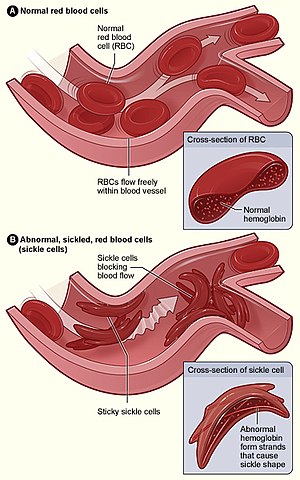- Understanding the Condition
- Symptoms
- Causes and Genetics
- Diagnosis
- Treatment Options
- Recent Advances in Treatment
- Living with the Disease
- Conclusion
What is Sickle Cell Disease?
Sickle Cell Disease (SCD) is a genetic blood disorder caused by mutations in the β-globin gene, resulting in the production of abnormal hemoglobin known as hemoglobin S (HbS). This condition leads to the deformation of red blood cells into a sickle shape, causing various complications and affecting the quality of life of individuals with the disease.
Understanding the Condition
Sickle Cell Disease is a hereditary condition that affects the shape and function of red blood cells. Under normal circumstances, red blood cells are round and flexible, allowing them to move easily through blood vessels. However, in individuals with SCD, the red blood cells become rigid and crescent-shaped. This abnormal shape can cause blockages in blood flow, leading to pain, anemia, and other serious health problems.
Symptoms
The symptoms of SCD can vary from person to person but often include:
- Pain Crises: Also known as vaso-occlusive crises, these are sudden episodes of severe pain caused by blocked blood flow.
- Anemia: Due to the rapid breakdown of sickle-shaped cells, individuals with SCD often experience chronic anemia, leading to fatigue and weakness.
- Infections: Sickle cells can damage the spleen, making individuals more susceptible to infections.
- Organ Damage: Over time, the repeated blockage of blood flow can cause damage to organs such as the liver, kidneys, lungs, and heart.
Causes and Genetics
Sickle Cell Disease is caused by a mutation in the gene that tells the body how to make hemoglobin. This mutation is inherited in an autosomal recessive pattern, meaning that a person must inherit two copies of the sickle cell gene (one from each parent) to have the disease. If an individual inherits only one sickle cell gene, they are a carrier (sickle cell trait) and usually do not exhibit symptoms.
Diagnosis
SCD is typically diagnosed through a blood test that checks for the presence of hemoglobin S. Newborn screening programs in many countries test for SCD at birth, allowing for early diagnosis and management.
Treatment Options
The management of Sickle Cell Disease involves both prevention of complications and treatment of symptoms. Key treatments include:
- Medications: Hydroxyurea is commonly used to reduce the frequency of pain crises and the need for blood transfusions. L-glutamine is another medication that helps reduce the complications of SCD.
- Blood Transfusions: Regular blood transfusions can help prevent complications such as stroke.
- Pain Management: Pain management strategies include over-the-counter pain relievers, prescription opioids, and physical therapy.
- Stem Cell Transplantation: A stem cell transplant, also known as a bone marrow transplant, can potentially cure SCD, but it is a high-risk procedure and not suitable for all patients.
Recent Advances in Treatment
Recent advances in the treatment of SCD offer hope for improved outcomes. Gene therapy and new medications targeting specific pathways involved in the disease are currently being developed and tested in clinical trials. These advancements aim to provide more effective and less invasive treatment options for individuals with SCD.
Living with the Disease
Living with SCD requires ongoing medical care and lifestyle adjustments. Individuals with SCD should:
- Stay Hydrated: Drinking plenty of water can help prevent pain crises.
- Avoid Extreme Temperatures: Extreme cold or heat can trigger pain crises.
- Regular Check-Ups: Regular medical check-ups are essential for monitoring the disease and managing complications.
- Healthy Diet: A balanced diet rich in vitamins and minerals supports overall health.
Conclusion
Sickle Cell Disease is a challenging condition that requires comprehensive care and management. Advances in medical research continue to improve the quality of life and outcomes for individuals with SCD. Early diagnosis, regular medical care, and advancements in treatment options provide hope for those living with this genetic disorder.
Sources
Sickle-cell disease:
https://www.thelancet.com/journals/lancet/article/PIIS0140-6736(10)61029-X/abstract
Sickle Cell Disease: Advances in Treatment:
https://www.ochsnerjournal.org/content/18/4/377.short
Recent Advances in the Treatment of Sickle Cell Disease:
https://www.frontiersin.org/journals/physiology/articles/10.3389/fphys.2020.00435/full
Advances in the diagnosis and treatment of sickle cell disease:
https://link.springer.com/article/10.1186/s13045-022-01237-z

